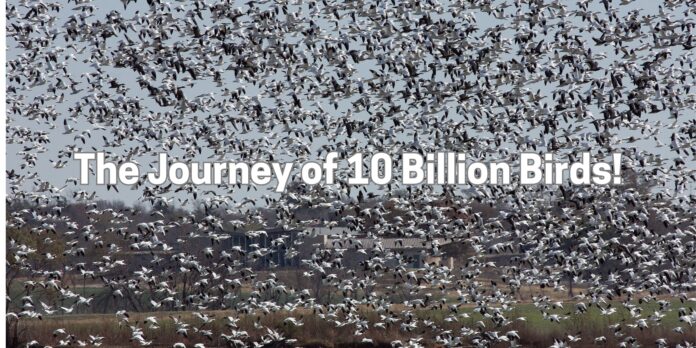Billions of birds are flying south for the annual fall migration, including 4.7 billion leaving the U.S. alone, bound for Mexico, Central and South America. Sadly, over the past 50 years, North American bird populations dropped by nearly 3 billion, due to habitat loss, climate change, and massive development along their flight paths. An estimated one billion deaths per year are due to building collisions, with light pollution being an amplifying factor.
We (scientists, conservationists, media and the public) know this because of volunteers, citizen scientists like you, who shared their local observations using free apps and online data forms!
Here’s YOUR chance to get involved. Below, we feature projects and events in need of your help.
And if you can choose only one day to participate, try Global Big Day on October 12th! You’ll contribute to a massive database of bird migratory patterns and populations, which is especially useful for researchers working to monitor and protect migratory species.
Credit: BirdCast
Is there a fast-moving front of wood ducks, snow geese and widely scattered warblers in your forecast tonight? Find out with BirdCast, the website and app that predicts what migratory birds will be flying overhead in your area. You can see current conditions and future forecasts to help plan your birding adventures.
Cyanistes caeruleus (Credit:Jonas Traber)
Use eBird to record and report your bird observations during the fall migration! Your reports will be combined with those of an international network of eBird users. eBird then shares these observations with a global community of educators, land managers, ornithologists, and conservation biologists.
Yellow-throated Warbler (Setophaga dominica) (Credit: Ryan Sanderson/ Macaulay Library
Identify birds sight unseen with the Merlin app! Not only does it listen for bird songs and calls and compare them to those in the extensive Cornell Lab’s McCauley Library, but it also uses your location to calculate the most likely match. Merlin is already incredibly accurate, and thanks to AI, it’s getting better and better.
Credit: Manomet Conservation Sciences
You don’t have to live near the ocean to contribute to International Shorebird Survey; it’s for everyone in the western hemisphere. Shorebirds migrate over much of Canada, the United States, and Mexico, as well as Central and South America. Use the eBird website or app and select ISS from the drop-down menu.
Los Angeles at night (Credit: iStock)
Artificial light distracts and disorients birds as they migrate south each fall. Light pollution also causes sleep disorders in people, and disrupts the sleeping, breeding and migration habits of animals, especially birds. Join Globe at Night to learn how to measure night sky brightness and help create a light pollution map worldwide. Tip: consider turning off your outside lighting between mid-August and early November to reduce bird mortality during migrations.
Bird collision in US, 2024 (Credit: dBird)
Nearly a billion birds die from collisions with windows each year, many during the fall migration. Use dBird to report bird collisions in your area to help researchers monitor this important cause of bird mortality.
Credit: HHMI/Tangled Bank Studios
Shorebirds fly thousands of miles each year along ancient and largely unknown migratory routes called flyways. But their populations are crashing amidst climate change and urban development. Watch the inspiring short film Flyways to learn more about this extraordinary migration then participate in citizen science efforts to document and protect migratory birds. You’ll also find a list of libraries hosting watch parties and bird conservation activities!
Source : Discovermagazine













